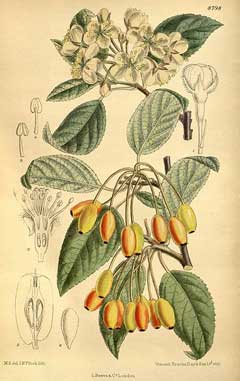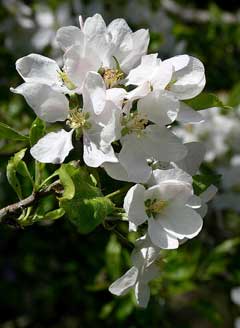 |
|
http://commons.wikimedia.org/wiki/File:Malus_rivularis_145-8798.jpg |
 |
| http://www.flickr.com/photos/jim-sf |
Translate this page:
Summary
Physical Characteristics

 Malus_fusca is a deciduous Tree growing to 12 m (39ft 4in) at a slow rate.
Malus_fusca is a deciduous Tree growing to 12 m (39ft 4in) at a slow rate.
See above for USDA hardiness. It is hardy to UK zone 6 and is not frost tender. It is in flower in May. The species is hermaphrodite (has both male and female organs) and is pollinated by Insects.
It is noted for attracting wildlife.
Suitable for: light (sandy), medium (loamy) and heavy (clay) soils, prefers well-drained soil and can grow in heavy clay soil. Suitable pH: mildly acid, neutral and basic (mildly alkaline) soils. It can grow in semi-shade (light woodland) or no shade. It prefers moist soil.
UK Hardiness Map
US Hardiness Map
Synonyms
M. rivularis.
Plant Habitats
Edible Uses
Fruit - raw or cooked[11, 101]. Up to 2cm in diameter[229]. An agreeable sub-acid taste, it can be eaten out of hand or made into jellies, preserves etc[183]. The fruit can be left on the tree until there have been some autumn frosts, this will soften the fruit and make it somewhat less acid[K]. The fruit is rich in pectin so it can be added to pectin-low fruits when making jams or jellies[183, 257]. Pectin is also said to protect the body against radiation[201].
References More on Edible Uses
Medicinal Uses
Plants For A Future can not take any responsibility for any adverse effects from the use of plants. Always seek advice from a professional before using a plant medicinally.
Oregon crab was employed medicinally by several native North American Indian tribes who used it to treat a variety of complaints[257]. In particular, it gained a reputation with some tribes as a heal-all, especially useful for treating any of the internal organs[257]. It is little, if at all, used in modern herbalism. The trunk, bark and inner bark are antirheumatic, astringent, blood purifier, cardiac, diuretic, laxative and tonic[257]. A decoction has been used in the treatment of coughs, stomach ulcers, dysentery, diarrhoea, rheumatism and consumption[257]. The shredded bark has been used to treat blood spitting[257]. A poultice of the chewed bark has been applied to wounds[257]. An infusion of the bark is used as an eyewash[257]. a decoction of the bark is used as a wash on cuts, eczema and other skin problems[257]. An infusion of the bark, combined with wild cherry bark (Prunus sp.) has been used as a cure-all tonic[257]. The juice scraped from the peeled trunk has been used as an eye medicine[257]. The soaked leaves have been chewed in the treatment of lung problems[257].
References More on Medicinal Uses
The Bookshop: Edible Plant Books
Our Latest books on Perennial Plants For Food Forests and Permaculture Gardens in paperback or digital formats.

Edible Tropical Plants
Food Forest Plants for Hotter Conditions: 250+ Plants For Tropical Food Forests & Permaculture Gardens.
More

Edible Temperate Plants
Plants for Your Food Forest: 500 Plants for Temperate Food Forests & Permaculture Gardens.
More

More Books
PFAF have eight books available in paperback and digital formats. Browse the shop for more information.
Shop Now
Other Uses
The fruit is a source of pectin[183]. Wood - hard, close grained, durable. Used for mallets, tool handles and bearings[11, 82, 99, 101, 226].
Special Uses
References More on Other Uses
Cultivation details
An easily grown plant, it succeeds in most fertile soils, preferring a moisture retentive well-drained loamy soil[1, 200]. Grows well in heavy clay soils. Prefers a sunny position but succeeds in partial shade, though it fruits less well in such a situation[200]. A very ornamental plant[1], it is slow-growing in the wild[229]. Hybridizes freely with other members of this genus[200]. The fruit is a good wildlife food source, especially for birds[200]. Plants in this genus are notably susceptible to honey fungus[200].
References Carbon Farming Information and Carbon Sequestration Information
Temperature Converter
Type a value in the Celsius field to convert the value to Fahrenheit:
Fahrenheit:
The PFAF Bookshop
Plants For A Future have a number of books available in paperback and digital form. Book titles include Edible Plants, Edible Perennials, Edible Trees,Edible Shrubs, Woodland Gardening, and Temperate Food Forest Plants. Our new book is Food Forest Plants For Hotter Conditions (Tropical and Sub-Tropical).
Shop Now
Plant Propagation
Seed - best sown as soon as it is ripe in the autumn in a cold frame. It usually germinates in late winter. Stored seed requires stratification for 3 months at 1°c and should be sown in a cold frame as soon as it is received[200]. It might not germinate for 12 months or more. Prick out the seedlings into individual pots as soon as they are large enough to handle. If given a rich compost they usually grow away quickly and can be large enough to plant out in late summer, though consider giving them some protection from the cold in their first winter. Otherwise, keep them in pots in a cold frame and plant them out in late spring of the following year. Cuttings of mature wood, November in a frame[11].
Other Names
If available other names are mentioned here
Native Range
NORTHERN AMERICA: United States (Alaska (south), Oregon (west), Washington (west), California (northwest)), Canada (British Columbia (west))
Weed Potential
Right plant wrong place. We are currently updating this section.
Please note that a plant may be invasive in one area but may not in your area so it’s worth checking.
Conservation Status
IUCN Red List of Threatened Plants Status :

Growth: S = slow M = medium F = fast. Soil: L = light (sandy) M = medium H = heavy (clay). pH: A = acid N = neutral B = basic (alkaline). Shade: F = full shade S = semi-shade N = no shade. Moisture: D = dry M = Moist We = wet Wa = water.
Expert comment
Author
(Raf.)Schneid.
Botanical References
60200
Links / References
For a list of references used on this page please go here
Readers comment